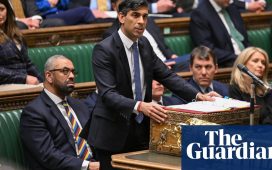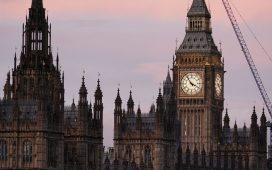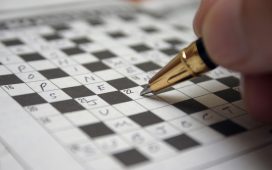The Prince of Wales has coronavirus, it emerged on Wednesday, as hundreds of guests at a Commonwealth service attended by Charles and the Queen were told a flag-bearer at the event had tested positive for coronavirus.
Charles was said to be “up and about” and in good spirits at Birkhall, his 53,000-acre Highland estate in Scotland. He was tested on Monday after experiencing mild symptoms.
Meanwhile pictures emerged of the Queen conducting her weekly audience with Boris Johnson by telephone from Windsor Castle. The monarch has held the weekly meeting with whoever is prime minister throughout her reign.
Clarence House said in a statement: “It is not possible to ascertain from whom the prince caught the virus owing to the high number of engagements he carried out in his public role during recent weeks.”
Charles joined the Queen, the Duchess of Cornwall, the Duke and Duchess of Cambridge and the Duke and Duchess of Sussex at a Commonwealth Day service at Westminster Abbey on 9 March. About 2,000 people, including politicians, ambassadors and schoolchildren, also attended the service.
It emerged on Wednesday that a person present at the service, understood to be one of the 54 flag-bearers, had also since tested positive for the Covid-19 virus. A Commonwealth secretariat spokesperson said: “Staff and other guests were informed immediately and urged to follow WHO and NHS advice. All staff are currently working from home.”
Symptoms are defined by the NHS as either:
- a high temperature – you feel hot to touch on your chest or back
- a new continuous cough – this means you’ve started coughing repeatedly
NHS advice is that anyone with symptoms should stay at home for at least 7 days.
If you live with other people, they should stay at home for at least 14 days, to avoid spreading the infection outside the home.
After 14 days, anyone you live with who does not have symptoms can return to their normal routine. But, if anyone in your home gets symptoms, they should stay at home for 7 days from the day their symptoms start. Even if it means they’re at home for longer than 14 days.
If you live with someone who is 70 or over, has a long-term condition, is pregnant or has a weakened immune system, try to find somewhere else for them to stay for 14 days.
If you have to stay at home together, try to keep away from each other as much as possible.
After 7 days, if you no longer have a high temperature you can return to your normal routine.
If you still have a high temperature, stay at home until your temperature returns to normal.
If you still have a cough after 7 days, but your temperature is normal, you do not need to continue staying at home. A cough can last for several weeks after the infection has gone.
Staying at home means you should:
- not go to work, school or public areas
- not use public transport or taxis
- not have visitors, such as friends and family, in your home
- not go out to buy food or collect medicine – order them by phone or online, or ask someone else to drop them off at your home
You can use your garden, if you have one. You can also leave the house to exercise – but stay at least 2 metres away from other people.
If you have symptoms of coronavirus, use the NHS 111 coronavirus service to find out what to do.
Source: NHS England on 23 March 2020
Charles, 71, was tested by the NHS after fulfilling the criteria in Aberdeenshire given his age and symptoms. He is self-isolating away from the Duchess of Cornwall, 72, also at Birkhall, but who has tested negative for the virus. She is also self-isolating.
The announcement by Clarence House raised immediate concerns for the health of the Queen. She last saw Charles on 12 March, following an investiture at Buckingham Palace, when the two met briefly. Doctors believe the earliest Charles would have been infectious is 13 March.
Buckingham Palace said: “Her Majesty the Queen remains in good health. The Queen last saw the Prince of Wales briefly on the morning of 12 March and is following all the appropriate advice with regard to her welfare.”
Charles’s last public engagement was also on 12 March, when he attended a Mansion House dinner hosted by William Russell, the lord mayor of the City of London, and George Brandis, the high commissioner for Australia, in aid of the bushfire relief and recovery effort.
The prince attended a WaterAid meeting in central London on 10 March. Prince Albert of Monaco, who revealed five days ago that he had tested positive for Covid-19, was also at the meeting.
Medical advice is that it is unlikely Charles’s condition will escalate into a more serious case. He is thought to have first exhibited symptoms over the weekend, but they were not pronounced enough for him to reconsider his travel plans.
There was no comment on exactly what symptoms Charles had displayed, except that they were mild.
He and the duchess arrived at Birkhall, which is on the Balmoral estate, on Sunday. There is a small team of domestic staff with them, which will remain. The couple are said not to be interacting physically with their staff.
Charles has spoken both to the Duke of Cambridge, who is in Norfolk, and the Duke of Sussex, who is on Vancouver Island, since his diagnosis.
Though he has had no public engagements since 12 March, he has hosted a small number of private meetings at Highgrove, his home in Gloucestershire, on Duchy of Cornwall business. The relevant people have been informed, but it is not known if they have been tested.
The couple fulfilled the criteria for testing by the NHS in Scotland. A spokesperson for the Scottish government said in statement: “Dr Catherine Calderwood, chief medical officer for Scotland, has confirmed that their Royal Highnesses the Duke and Duchess of Rothesay [their official titles in Scotland] were tested for Covid-19 for clinical reasons. She is very pleased to confirm that both remain in good health.”














